- Home
- Alice Munro
Family Furnishings
Family Furnishings Read online
ALSO BY ALICE MUNRO
Dear Life
Too Much Happiness
The View from Castle Rock
Runaway
Hateship, Friendship, Courtship, Loveship, Marriage
The Love of a Good Woman
Open Secrets
Friend of My Youth
The Progress of Love
The Moons of Jupiter
The Beggar Maid
Something I’ve Been Meaning to Tell You
Lives of Girls and Women
Dance of the Happy Shades
Selected Stories
Carried Away
Vintage Munro
THIS IS A BORZOI BOOK
PUBLISHED BY ALFRED A. KNOPF
Copyright © 2014 by Alice Munro
All rights reserved. Published in the United States by Alfred A. Knopf, a division of Random House LLC, New York, and simultaneously by McClelland & Stewart, an imprint of Random House of Canada Limited, Toronto, Penguin Random House companies.
www.aaknopf.com
Knopf, Borzoi Books, and the colophon are registered trademarks of Random House LLC.
All of the stories herein were previously published in the following collections:
Dear Life (Alfred A. Knopf, New York, and Douglas Gibson Books, Toronto, 2012)
Hateship, Friendship, Courtship, Loveship, Marriage (Alfred A. Knopf, New York, and McClelland & Stewart, Toronto, 2001)
The Love of a Good Woman (Alfred A. Knopf, New York, and McClelland & Stewart, Toronto, 1998)
Runaway (Alfred A. Knopf, New York, and McClelland & Stewart, Toronto, 2004)
Too Much Happiness (Alfred A. Knopf, New York, and Douglas Gibson Books, Toronto, 2009)
The View from Castle Rock (Alfred A. Knopf, New York, and McClelland & Stewart, Toronto, 2006)
Library of Congress Cataloging-in-Publication Data
Munro, Alice, 1931–
[Short stories. Selections]
Family furnishings : selected stories, 1995–2014 / Alice Munro.—First edition.
pages cm
“This is a Borzoi book”—Title page verso.
Summary: “A selection of short stories by the Nobel Prize–winning author, Alice Munro”—Provided by publisher.
ISBN 978-1-101-87410-3 (hardback)—ISBN 978-1-101-87411-0 (eBook)
I. Munro, Alice, 1931– Love of a good woman. II. Title.
PR9199.3.M8A6 2014
813'.54—dc23 2014023046
eBook ISBN 9781101874110
This is a work of fiction. Names, characters, places, and incidents either are the product of the author’s imagination or are used fictitiously. Any resemblance to actual persons, living or dead, events, or locales is entirely coincidental.
Cover design by Carol Devine Carson
v4.0
ep
Contents
Cover
Also by Alice Munro
Title Page
Copyright
Foreword
The Love of a Good Woman
Jakarta
The Children Stay
My Mother’s Dream
Hateship, Friendship, Courtship, Loveship, Marriage
Family Furnishings
Post and Beam
The Bear Came Over the Mountain
Runaway
Soon
Passion
The View From Castle Rock
Working for a Living
Hired Girl
Home
Dimensions
Wood
Child’s Play
Too Much Happiness
To Reach Japan
Amundsen
Train
The Eye
Dear Life
Bibliographic Note
A Note About the Author
Foreword
IN 1971, ALICE MUNRO PUBLISHED HER SECOND BOOK, Lives of Girls and Women. Sometimes I read the title as an assertion of the importance of the lives of girls and women, and sometimes I read the title as a self-effacing acknowledgement, or even a warning—these are only the lives of girls and women; don’t bother to read about them if you don’t care. And in this paradox resides the literary career of a great writer who is simultaneously strange and down-to-earth, daring and straightforward. I cannot read any Alice Munro story without believing every word, as if Alice herself is inside the head of Sophia Kovalevsky (“Too Much Happiness”), or the head of a woman whose husband has murdered their three children (“Dimensions”), or the head of a man whose wife is institutionalized with dementia (“The Bear Came over the Mountain”). As a reader and as a writer, I embrace every phrase and every observation almost without being able to help myself, because every one seems as true as true and as involving as can be.
Munro’s style has always asked to be taken at face value. “The Love of a Good Woman,” the opening story of this collection of stories that Munro has published since the mid-nineties, begins, “For the last couple of decades, there has been a museum in Walley, dedicated to preserving photos and butter churns and horse harnesses and an old dentist’s chair and a cumbersome apple peeler and such curiosities as the pretty little porcelain-and-glass insulators that were used on telegraph poles.” She is promising no drama, no transcendence, only the peculiarity of objects that contain the history of our world and our ancestors, if not ourselves. The adjectives gather toward the end of the sentence like fireflies—“old,” then “cumbersome,” then “pretty little,” applied to something that almost no one might have noticed. Through these adjectives, Munro’s consciousness enters the museum, and the promise is that history will come alive, not the history of great events or famous people but of those who might have made practical use of these objects indoors and outdoors. “The Love of a Good Woman” is full of moral reversals and paradoxes—it is, in fact, a murder mystery transformed into an everyday event, and therefore much more interesting, since the actions and motives of the characters remain unknown to some and consciously hidden by others. What we come to care about is not what happened to the man who is found by some boys, drowned in his car in the middle of a lake, but the emotional life and the thought processes of Enid, a good woman, who makes her living caring for difficult patients, and who has a lingering fondness for Rupert, a boy she and her friends had teased in middle school. Those random objects in the first sentence, attended to by the narrative voice, promise detail, contemplation, care.
In a short interview Munro did with Deborah Treisman, for The New Yorker upon the publication of her last book of stories, Dear Life, Munro reflects on her choice of form with typical modesty. She says, “For years and years I thought that stories were just practice, till I got time to write a novel. Then I found that they were all I could do, and so I faced that. I suppose that my trying to get so much into stories has been a compensation.” Munro, though, has made of the short story something new, using precision of language and complexity of emotion to cut out the relaxed parts of the novel and focus on the essence of transformation. One of my favorite stories in this volume is “Too Much Happiness,” which I might have written as a three-hundred-page historical account. Sophia Kovalevsky is that rarest of beings, a female mathematical genius, and Russian, to boot. She wins a prestigious prize but has a hard time finding employment, she marries for escape, not love, and must juggle her talents, her obligations, and her social position every minute of every day. Munro begins in her usual authoritative way, signaling that she understands Sophia’s mathematical insights, and she weaves into the narrative Sophia’s past and present dilemmas, getting close enough for us to witness Sophia’s surprise at the sight of her lover in a crowd, then far enough away for us to survey the landscape Sophia travels through in her attempt to escape a smallpox
outbreak. Sophia is convincingly Russian, convincingly a woman of her time, convincingly appealing. The arc of her very dramatic story lasts seventy-five pages, and then is done, reduced, concentrated, left to simmer in the reader’s mind with all sorts of thoughts about the history of women, and one’s own history of trying to make something of the life one is given, overwhelming and too soon finished, for since Munro’s chosen form is the short story, her overriding theme is brevity—look now, act now, contemplate now, because soon, very soon, this thing that involves you will be over.
Perhaps Alice Munro’s particular brilliance to a novelist like me is her inventiveness. A novelist may come up with a couple of dozen ideas in a productive lifetime—or many fewer (Jane Austen, six; F. Scott Fitzgerald, five; Harper Lee, one)—but a writer of stories is a receiver of tales, gossip, anecdotes, and incidents, a person so alert, so attentive, so imaginative that any event might be made into a work of art. In the course of her career, Munro has published one novel and 139 stories. She has always been investigative of both her own experience and the experiences of others; in the last six volumes, written since 1996, she has gotten more experimental rather than less. Every story has given us the Alice Munro we thought we knew from “Royal Beatings” and “The Beggar Maid,” plus another Alice Munro, familiar in her style and technique but ready to take on new subjects, new settings, new interpretations of old material. A good example of this last is “Working for a Living,” in which Munro delves more deeply into her own family life, especially from the perspective of her father—how he got into the fox-fur business just at the wrong time, and what it meant, once that business failed, for him to go to work at a local foundry as a caretaker. Into this story of what might be considered tragedy or failure, Munro inserts not only her customary compassion and complexity, but also an intriguing larger picture—family history set into geography, geology, and ecosystem, moments of memory that explode into both feeling and analysis. A daughter’s love drives the story, but so does a man’s sense of himself.
Or maybe my favorite story in this volume is “The View from Castle Rock,” also a historical narrative, but entirely unlike “Too Much Happiness.” It is based on Munro’s investigations into her (Laidlaw) family’s background in a peculiar part of a peculiar country, the Ettrick Valley in Scotland, between the English border and Edinburgh, also the home of James Hogg, a Laidlaw cousin who published one of the most interesting and prophetic novels of his day, The Private Memoirs and Confessions of a Justified Sinner. “The View from Castle Rock” accompanies the Laidlaw immigrants to America, employing the present tense so evocatively and with such convincing feelings (not only emotions, but also sights, sounds, sensations) that even the author herself must step back and write, “And I am surely one of the liars the old man talks about, in what I have written about the voyage. Except for Walter’s journal, and the letters, the story is full of my invention.” Like every Munro story, this autobiographical narrative packs an unexpected, hidden punch, reminding us in the twenty-first century that what is gained grows out of what is lost, and our main responsibility is to understand both sides of the equation.
In her Nobel Prize interview, Munro comments on the benefits of growing up and beginning to write in the middle of nowhere. Asked if she was intimidated by the idea of writing, she says, “I don’t think I could have been so brave if I had been living in a town, competing with people on what can be called a generally higher cultural level. I didn’t have to cope with that. I was the only person I knew who wrote stories, though I didn’t tell them to anybody, and as far as I knew, at least for a while, I was the only person who could do this in the world.” It is a familiar arc for a writer—like that of Nikolai Gogol, growing up in Ukraine, like that of Jane Austen, slipping her writings under a sheet of blotting paper when other members of her family come into the room, like that of George Eliot, rusticated in Warwickshire, it is the tale of a child who feels a kinship, and even a sense of equality, with unknown authors of books, a child who listens, reads, tells herself stories (and changes the endings—in the same interview Munro recalls listening to “The Little Mermaid,” then retelling it to herself so that it ends without suffering), a child who pays attention to the people around her because they are the humans nearby, and their lives have plenty of worth and plenty of suspense, no matter what people from cities might think of them.
I would not call Alice Munro a political writer (though she says in her interview, “I never knew about the word ‘feminism,’ but of course I was a feminist”). Of her intentions, she says, “What I wanted was every last thing, every layer of speech and thought, stroke of light on bark or walls, every smell, pothole, pain, crack, delusion, held still and held together—radiant, everlasting” (Lives of Girls and Women). In avoiding the novel, she also seems to have avoided the pitfalls of political theory, à la Tolstoy or Zola, Vargas Llosa or Virginia Woolf. Even so, underlying all of her work there is a political assertion—that the lives of girls and women, the lives of hired girls and men who work in foundries, the lives of unfaithful wives and faithful wives, the lives of bullies and the bullied are all equally complex and equally worthy of portrayal. About halfway into “Hateship, Friendship, Courtship, Loveship, Marriage,” for example, we meet Edith and Sabitha, two girls who are thrown together almost by chance, and who turn out to be steering the progress of the romance that is the subject of the story in an entirely unexpected way, more or less as a joke upon the protagonist, Johanna, whom they disdain. They are not alike—Sabitha possesses a common streak of adolescent cruelty, but Edith, even though she goes along with the tease, does not, and the reader feels both her discomfort and her readiness to see what might happen. In “Dimensions,” Munro dares to suggest that a man who kills his children not only has an inner life, but that his inner life ends up being the very thing that gives a bit of comfort to his wife. Is Munro on the man’s side simply because she sees him as human? Her thinking is too complex for that—she strives to see him whole, to understand the point of view of someone most people must recoil from, and in doing so, she offers the reader a gift about what it means to be human.
In addition to the Nobel, Munro has won as many prizes as any other living writer—twenty-two in all, including three Governor General’s Prizes and two Giller Prizes, in Canada, the National Book Critics’ Circle Award and three O. Henry Awards in the United States, and the Mann Booker International Prize in the U.K., given for a body of work, like the Nobel, rather than for a single book. What do we make of this? Well, for one thing, her level of accomplishment remains steady—the care and thought she puts into her stories have not tapered off, rather she builds on earlier work without somehow betraying it. This is highly unusual in an author, and shows, I think, an inherently contemplative temperament, an ability to think through her subject, to see it from every angle, and to incorporate her perceptions so that the subject seems to be completely explored. Almost uniquely self-aware, she knows this—in “Home,” a story of a middle-aged woman’s return to the very place she had always longed so deeply to escape and then remembered obsessively, she writes, “It has changed for me. I have written about it and used it up. Here are more or less the same banks and hardware and grocery stores and the barbershop and the Town Hall tower, but all their secret, plentiful messages for me have drained away.” When we finish one of Munro’s stories we feel that she has given us all that we need to know—I find it almost impossible to read more than a single story in a day, and some of the long ones, like “The View from Castle Rock,” invite me to take my time, to savor each paragraph. If the material is sensational, Munro tempers it with thought and insight, so that I am invited to look deeply at it. And yet her style is always accessible, her characters and her incidents recognizable. Unlike many modernist authors (say, James Joyce), Munro does not assert that subjectivity should be privileged and that the inner lives of others, as depicted in words, are almost incomprehensible—she asserts that the world we all share is continually interesti
ng, continually worthy of investigation, that we can, and should attempt to understand one another, that the payoff for that attempt at understanding might be something utterly unexpected, like the comfort Doree takes, in “Dimensions,” in her husband’s imagination of the afterlives of their murdered children.
In 1983, Benjamin DeMott wrote in The New York Times, “Witty, subtle, passionate, [The Moons of Jupiter is] exceptionally knowledgeable about the content and movement—the entanglements and entailments—of individual human feeling. And the knowledge it offers can’t be looked up elsewhere.” But Munro arouses in her readers more than praise and respect. When she won the Nobel shortly after declaring that she didn’t plan to write anymore, the tributes that poured in were those of devotees—Julian Barnes wrote, “I have sometimes tried to work out how she does it but never succeeded, and I am happy in this failure, because no one else can—or should be allowed to—write like the great Alice Munro.” Sheila Heti wrote, “You look at her and think, Of course, just put all of your intelligence and sensitivity and vitality into your work in a consistent way. There is nothing else. She lives in a small town, has had the same agent since the seventies, doesn’t review books or do many interviews. She seems not to waste her time. She just goes straight to what matters most.” Lorrie Moore wrote, “Her genius is in the strange detail that resurfaces, but it is also in the largeness of vision being brought to bear (and press on) a smaller genre or form that has few such wide-seeing practitioners. She is a short-story writer who is looking over and past every ostensible boundary, and has thus reshaped an idea of narrative brevity and reimagined what a story can do.” Perhaps my favorite tribute is by Canadian author David Macfarlane: “I asked myself this question while reading ‘Cortes Island’ the other morning. The sun was just coming up. The coffee was almost gone. And even though I was paying such enjoyably close attention to Alice Munro, I couldn’t quite figure out how she does what she does. I’m guessing by magic. And I decided, as I continued reading, to leave it at that.”

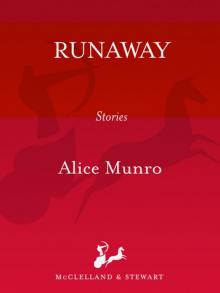 Runaway
Runaway Lives of Girls and Women
Lives of Girls and Women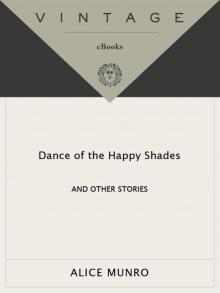 Dance of the Happy Shades
Dance of the Happy Shades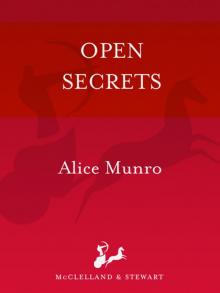 Open Secrets
Open Secrets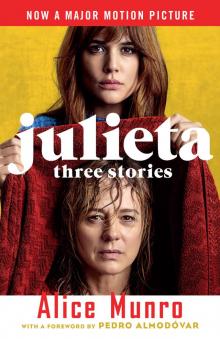 Julieta (Movie Tie-in Edition)
Julieta (Movie Tie-in Edition)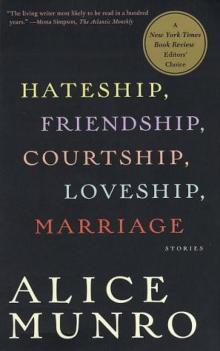 Hateship, Friendship, Courtship, Loveship, Marriage: Stories
Hateship, Friendship, Courtship, Loveship, Marriage: Stories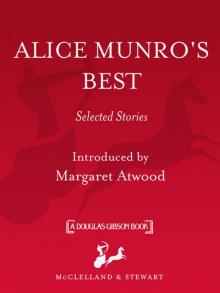 Alice Munro's Best
Alice Munro's Best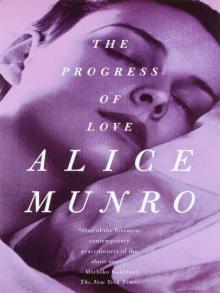 The Progress of Love
The Progress of Love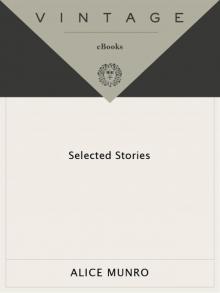 Selected Stories
Selected Stories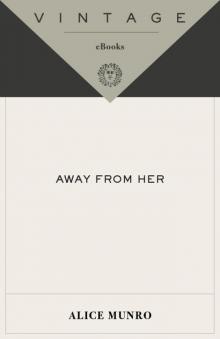 Away from Her
Away from Her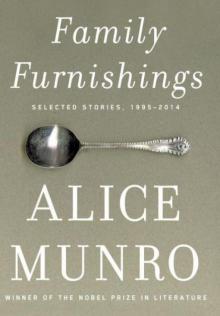 Family Furnishings
Family Furnishings Moons of Jupiter
Moons of Jupiter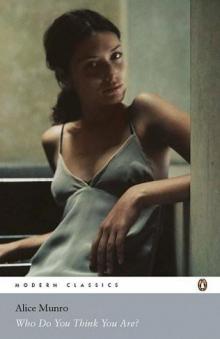 Who Do You Think You Are?
Who Do You Think You Are?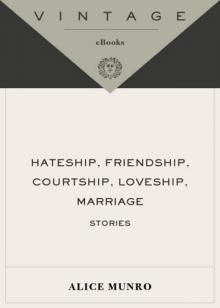 Hateship, Friendship, Courtship, Loveship, Marriage
Hateship, Friendship, Courtship, Loveship, Marriage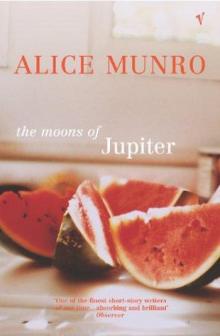 The Moons of Jupiter
The Moons of Jupiter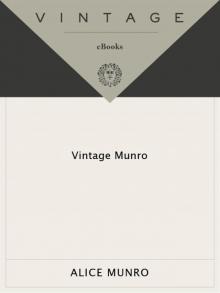 Vintage Munro
Vintage Munro The Love of a Good Woman
The Love of a Good Woman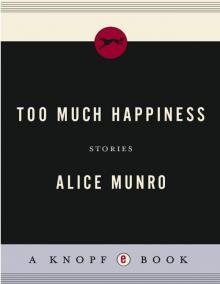 Too Much Happiness
Too Much Happiness Lying Under the Apple Tree
Lying Under the Apple Tree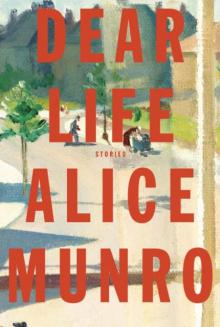 Dear Life
Dear Life Dear Life: Stories
Dear Life: Stories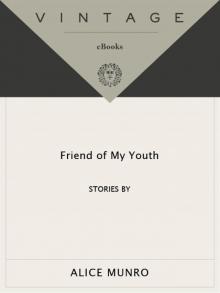 Friend of My Youth
Friend of My Youth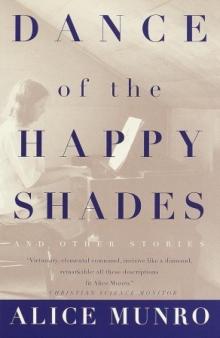 Dance of the Happy Shades: And Other Stories
Dance of the Happy Shades: And Other Stories The Beggar Maid
The Beggar Maid